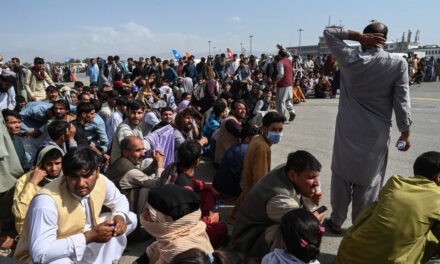I spent a good portion of my adult life working at the Pentagon. I’ve seen the direct impact of U.S. foreign entanglements in a way most people never could.
I also spent about four years executing plans for moving personnel in and out of countries. In Iraq in the 1990s, I was on the fourth plane getting in and the next to last one leaving hotspots on the ground.
This part of my life doesn’t come up much anymore. My past decade-plus has been more involved with trading the stock market. I found out I had a knack for it, and so that’s where I keep my frame of mind.
Last week’s events in Afghanistan, however, prompted me to do some thinking on the subject.
Not just about how it affects the geopolitical landscape moving forward, but how events such as this have become inexplicably divorced from finance in recent years.
In short, I believe this separation is coming to an end. It will have currently unimaginable effects on the financial well-being of every American.
No matter where our opinions lie, this is something we need to analyze objectively and thoughtfully. If we fail to do so, we’ll fail to protect ourselves against the sheer vulnerability of U.S. operations both overseas and here at home.
To start, let me be clear that I’m not a political commentator and never have been.
I have biases, but I spend as much time with The New York Times as I do with Fox News so I can understand how people think on both sides of the aisle.
It’s rare that these two sources agree. The past week, though, they’ve largely agreed that the events in Afghanistan are a tragedy. It seems everyone does.
Consensus around tragic events can unite the country. A recent example was 9/11, when politicians completely forgot about their differences and united for a common cause.
That doesn’t seem to be happening right now, but as events continue to deteriorate it’s possible both parties will begin to work together again.
However, it seems unlikely that anyone is going to take responsibility for what happened.
A Failure in Protocol
Let me first give you some background.
In the 1990s, I spent a lot of time deploying at the beginning and end of missions around the world. Many of you will remember this as a time when the U.S. was involved in conflicts overseas, most notably in Iraq.
So I can say with certainty, despite the events of last week, that the U.S. military does know how to move people and equipment out of a country. It’s clear to me that there was a failure in protocol for this operation.
When I was working for the Pentagon, the first rule of getting out of a country was to never announce the date of the exit. The goal was to get people out safely and load the equipment on planes (or destroy it) before announcing the end of the mission.
Obviously this rule hasn’t been followed in Afghanistan, or there wouldn’t have been crowds of Afghan people on the runway hoping to escape at the last moment. That was mistake #1 for this operation.
Another obvious rule — one that shouldn’t even need to be mentioned — is to secure the runways until the very end.
Abandoning Bagram Airfield on July 1 seems like a mistake in hindsight, but it was clear that it was a mistake when the news was announced. Hopefully whoever made that decision will be fired before they make other decisions that result in the loss of life.
This was a complex withdrawal and should have followed the principles that have allowed millions of personnel to get home safely over the past few decades.
So the fact that it was a disaster at all has some important investment implications.
Decisions on exit strategies come from the top. The military advises the White House, but ultimately the White House gives the Pentagon its orders. This means there’s a chance the White House isn’t listening to the experts. As investors, we need to take this possibility into consideration.
What This Means for Your Portfolio
The U.S. stock market has enjoyed a strange period of detachment from global events over the last five years or so. Barring the COVID-19 pandemic, most geopolitical events that would once spook investors were met with a shrug.
My thinking is that the easy-money policies of the Fed kept any points of vulnerability in the stock market protected.
That’s why the next year is so dangerous.
We can hope the leadership in Washington is more competent than it demonstrated in the exit from Afghanistan. But hope is not a strategy. Who’s to say economists won’t also be ignored in a domestic financial crisis?
We need to prepare for the worst, especially over the next 15 months, as the politicians who screwed this up prepare for the mid-term election.
One risk is that Congress will try to overcompensate and pass ill-conceived programs hoping to make voters forget about Afghanistan. This could lead to runaway inflation. Or, if Congress begins pushing hard on a green agenda, regulations could cripple important parts of the economy — like the energy sector.
At the same time all this is happening, the Fed is taking concrete steps to unwind its balance sheet and, eventually, raise interest rates. Investors have grown more used to easy-money in recent years and aren’t likely to take such adjustments in stride.
Another risk is that the leaders who created this problem will face another crisis they can’t handle. This risk is high and could plainly lead to a bear market.
The failure to handle crises defined the Hoover presidency — which preceded the Great Depression — and the Carter administration, which saw double-digit inflation.
In the next year, we are likely to see another crisis. Afghanistan has demonstrated that the current leadership isn’t as skilled at crisis management as they think they are. This creates a dangerous world. And it is the most dangerous market environment we can face.
Put options, far from being a simple tool for speculation, should be viewed as a portfolio-preservation tool amid conditions like these. Purchasing such protection dated out through 2022 and early 2023 would be a wise move for any investor whose portfolio has enjoyed the bull market of recent years.
Regards,

Michael Carr
Editor, One Trade
Chart of the Day:
More Caution Signs Ahead
By Mike Merson, Managing Editor, True Options Masters

(Click here to view larger image.)
After forming a nice parallel uptrend channel from the start of 2021 (the blue lines), the S&P 500’s higher highs have decelerated a bit. Meanwhile, the lower line of the channel has stayed consistent.Today I want to take a look at the SPDR S&P 500 ETF (NYSEARCA: SPY), and the ever-tightening rising wedge it’s been forming since May.
The result is a shift from the uptrend channel into a much tighter rising wedge — a bearish pattern. The new key rising resistance line is in yellow.
At the same time, we’ve seen lower highs (purple line) on the Relative Strength Index (RSI). That, too, is a bearish sign for the index.
However, any chart pattern on the broad market indexes must be taken with a grain of salt. With all the excess liquidity in the system brought on by the Fed, it hasn’t paid well to be a bear in this market. There’s a clear backstop on stock prices falling too far.
Like Mike mentioned today, a genuine COVID-style crisis may be the only thing that can put a dent in this market. Buying some longer-dated puts at these levels would be a good way to counter that possibility.
Regards,

Mike Merson
Managing Editor, True Options Masters









